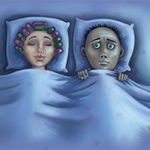“You should also ask questions about sleep quality,” says Dr. Degotardi. “Not just how much sleep they get, but how do they feel when they get up. Refreshed? Or groggy and lethargic and dragging themselves through the day?”
Doctors can also ask their patients’ partners for crucial information. Do they notice any snoring, choking, or gasping during the night? Twitching arms and legs might also be a sign of sleep apnea.
Occupational factors, too, are very important. Working during the late shift, for instance, “is really hard to cope with,” says Dr. Degotardi. Those who travel frequently between time zones or have lengthy commutes might also be at risk for disturbed sleep. “You spend a lot of time in the car, and then don’t go straight to bed when you get home,” she says.
Though some factors are beyond patients’ control, many sleeping problems are a result of lifestyle choices—something Dr. Degotardi terms volitional chronic sleep deprivation. “There’s so much to do in our lives: Get the kids’ lunches made, check the bus [driver’s] report, pay the bills. We tend to treat sleep as the time that we can really cut back on. You figure you’ll just go to bed later.”
Sometimes patients don’t realize how little sleep they’re getting. In these cases, it’s better to ask questions about specific symptoms. “One of the areas that’s really, really easy to pick up on is, are they falling asleep easily watching TV at night? Reading a book? Sitting in a hot room? All of these are signs of sleep deprivation,” says Dr. Degotardi. Finally, it’s important to ask patients about treatment strategies they may have already tried—like medication or yoga—so that you don’t recommend more of the same.
Document Patterns—Then Change Them
After a thorough interview, the next step is for patients to start keeping a sleep diary to record not only when they sleep, but how they’re feeling before and after. It’s especially useful at the beginning of treatment, as a baseline measure of problem areas on which to improve. “It really helps when talking about changes they might make,” explains Dr. Degotardi, “because you can track associations between behaviors they’re engaging in.”
Simple behavior changes start with making the bedroom comfortable, including having a good mattress, an optimal noise level, cool room temperature, and complete darkness. Before bed, light from a computer or a television can trigger the body to stay awake. If a person has to get up to use the bathroom in the middle of the night, the experts say it’s best not to turn on any lights. It’s also critical to form associative bonds between bed and sleep. “The feel and smell and sight of your bed should be cues for falling sleep, not for frustration and wakefulness,” says Dr. Degotardi. Even simply turning around the alarm clock to keep the digital readout from distracting you could help.



